|
|
|
Sort Order |
|
|
|
Items / Page
|
|
|
|
|
|
|
| Srl | Item |
| 1 |
ID:
128478
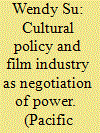

|
|
|
|
|
| Publication |
2014.
|
| Summary/Abstract |
This article explores the global-local interplay by analyzing the changing role of the Chinese state and its evolving cultural policy during its engagement with global Hollywood from 1994 to 2012. It further investigates the impact of the state policy on the formation of a domestic film industry. Drawing on both English and Chinese language sources and combining both primary and secondary empirical data, the article examines local strategies and resistance toward global Hollywood, and argues for the Chinese state's adaptive and negotiation capability that serves to reverse the power relationship in international communication. The state employs a strategy of taking advantage of Hollywood resources to build the domestic film industry in order to promote Chinese soft power. Therefore, by weaving both market forces and global capital into the state mechanism, the Chinese state effectively reinforces its authoritarian power.
|
|
|
|
|
|
|
|
|
|
|
|
|
|
|
|
| 2 |
ID:
091283


|
|
|
|
|
| Publication |
2009.
|
| Summary/Abstract |
This essay addresses itself to the century long history of cinema in Iran, focusing on the history of the senses as they combine with and are extended by film technologies. It argues that Khomeini's aim was to produce a transformed and Shiite Iran by purifying the sensorial national body by means of film technologies.
|
|
|
|
|
|
|
|
|
|
|
|
|
|
|
|
| 3 |
ID:
088482
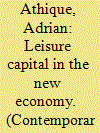

|
|
|
|
|
| Publication |
2009.
|
| Summary/Abstract |
The ascendance of the multiplex film theatre in India has great significance in the creation of new public space, and is part and parcel of the long-running contestation of modernity and citizenship in postcolonial India. However, while the histories of urbanism, cinema and modern politics are usefully indicative of each other, their relationship in this instance also needs to be further related to the history of leisure capital in India and, in particular, to the contemporary dynamics of the media economy. The rise of the multiplex is closely related to the re-organisation of working practices and of capital investment within the film exhibition sector. The aggregation of interests within what has traditionally been a highly fragmented industry with largely informal organisation is a result of both the entry of outside concerns into the theatrical market and of operational change within the industry itself as leading players pursue an agenda of 'corporatisation'. It is these new corporate entities, funded by institutional investors and public flotation, that dominate the multiplex business, which has arisen in marked contrast to the loose agglomeration of family-owned theatres that have previously characterised theatrical exhibition in India. As the leading multiplex brands embark upon a massive programme of expansion into India's second-tier cities, this paper provides a critical account of the emerging political economy of the multiplex paradigm.
|
|
|
|
|
|
|
|
|
|
|
|
|
|
|
|
| 4 |
ID:
090553
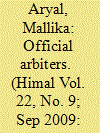

|
|
|
|
|
| Publication |
2009.
|
| Summary/Abstract |
Certainly not all films in Southasia have slipped under the censor's nose, a fact that only strengthens critics' concerns. After the 2002 Gujarat carnage, filmmaker Rakesh Sharma arrived in Gujarat and started talking to victims and eyewitnesses of the violence that followed the train burning incident in Godhra. For over a year, he interviewed people from both the Hindu and Muslim communities about the events. The result was his 2003 documentary Final Solution, a graphic portrayal of hate politics investigating the aftermath of the anti-Muslim carnage. The film also criticised Gujarat Chief Minister Narendra Modi for not doing anything to stop the violence, accusing him of inciting communal hatred. When the feature-length documentary was ready for exhibition, India's Central Board of Film Certification (CBFC) banned it. According to the body, the film would promote communal disharmony among Hindus and Muslims, by presenting the violence in Gujarat in a manner likely to arouse clashes. "State security is jeopardised and public order is endangered if this film is shown," said the CBFC, refusing to certify the work under India's Cinematography Act of 1952. "When it is judged in its entirety from the point of view of its overall impact, it is not advisable to be exhibited."
|
|
|
|
|
|
|
|
|
|
|
|
|
|
|
|
| 5 |
ID:
152074
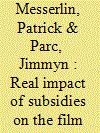

|
|
|
|
|
| Summary/Abstract |
Many countries are becoming interested in developing their film industries as a way of promoting their national culture and increasing their soft power. With the continued global dominance of Hollywood films, policy makers are increasingly considering government subsidies as an essential tool in promoting their national film industries. However, the actual effectiveness of subsidies in promoting a film industry remains debatable. In order to better address this issue, this paper evaluates and compares the experiences of France and Korea. Both countries have adopted exactly the same sequence of instruments—import quotas, screen quotas, and then subsidies—yet have applied almost the opposite subsidy policies. Since the 1950s, France has intensively used subsidies while Korea has not. After more than a half century, these different subsidy policies have led to very different outcomes. This paper shows that a film industry without significant government subsidies can prosper better in the long term than a heavily subsidized one. This is an important lesson for countries that want to develop their film industry and to promote their culture by designing effective film policies.
|
|
|
|
|
|
|
|
|
|
|
|
|
|
|
|
| 6 |
ID:
090552
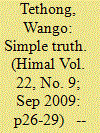

|
|
|
|
|
| Publication |
2009.
|
| Summary/Abstract |
Rare are tales of a lone individual challenging China's brutal censorship mechanism with a single act of bravery and determination. But that is the story of Dhondup Wangchen (see photo below). With the help of his friend, a Buddhist monk named Jigme Gyatso, also known as Golog Jigme, Wangchen has shown that limited means can be overcome to bring untold stories to global attention. In so doing, his plight has become a focal point for international Tibet-related publicity and activism at a time when, otherwise, related momentum had largely dissipated following the widespread protests of March-April 2008.
|
|
|
|
|
|
|
|
|
|
|
|
|
|
|
|
| 7 |
ID:
179207
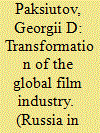

|
|
|
|
|
| Summary/Abstract |
The current rapid development of some Asian economies and the projected economic dominance of Asia in the 21st century are reasons enough to call it “the Asian century.” But will Asia’s economic growth entail an increase in political power and cultural influence? In this article the author looks at the topic through the lens of the film industry, a field of activity with a plethora of intertwined economic, political, and cultural factors. Cinema is studied here as an industry that produces “meanings” and is coupled with the concept of “strategic narratives.” According to some statistics, Asian cinema is becoming increasingly important in terms of the size of national film markets, but for a variety of reasons the U.S. remains the world’s most important exporter of motion pictures. The position of Asian countries in world cinematography is undermined by such global institutions as award ceremonies and film festivals that are held in the U.S. and Europe and tend to favor Western filmmakers. This article emphasizes the dramatic influence of digital transformation on modern cinematography and the opportunities it opens up for Asian film producers in creating a new, global streaming services market. Finally, the paper discusses development prospects for the film industries in four Asian leaders in this field—China, Japan, South Korea, and India. Japan and South Korea are likely to increase their cooperation with the U.S. in cinematography. There are great opportunities for cooperation between the film industries of India and China, but they are heavily dependent on political relations between the two nations. China’s film industry is expected to continue to develop rapidly.
|
|
|
|
|
|
|
|
|
|
|
|
|
|
|
|
| 8 |
ID:
090551


|
|
|
|
|
| Publication |
2009.
|
| Summary/Abstract |
Sometime in 1996, the High Court of Andhra Pradesh received an anonymous letter informing the court that pornographic films were being shown in a cinema hall called Ramakrishna 70MM. The court proceeded to send two 'lady advocates' to ascertain the facts. In their subsequent affidavit, the advocates informed the court that they had gone to watch a film in the theatre and, after repeated obstacles - the ticket seller refusing to sell them tickets, the doorman asking them to go home, etc - they finally managed to find a seat inside the theatre. There, they were promptly informed by the manager that the film that was to be screened could not be seen by ladies, and they were ordered to leave.
|
|
|
|
|
|
|
|
|
|
|
|
|
|
|
|
|
|
|
|
|